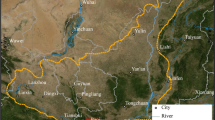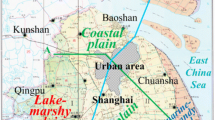Abstract
The upper 75 m of the alluvium beneath Shanghai can be divided into three clay layers. Consolidation of the upper soft clay contributes to the average 3 mm/year land subsidence which occurs in the Shanghai region, despite mitigation measures including reduction in groundwater exploitation from the underlying aquifer and groundwater recharge. Data indicate that the soft clay is semi-dispersed, marginally stable, and susceptible to compaction. The study reports an analysis of the granulometric characteristics and aggregate components, pore-size distribution, microstructure, pore solution composition and cation exchangeability of the soft clay. The results indicate the deformation/consolidation of the soft clay is related to its microscopic physical and chemical characteristics rather than the fluctuation of the groundwater level in the underlying aquifer.
Résumé
Les 75 m supérieurs d’alluvions sous la ville de Shanghai peuvent être divisés en trois couches argileuses. La consolidation de la couche supérieure d’argile molle contribue pour une moyenne de 3 mm/an à la subsidence qui s’observe dans la région de Shanghai, malgré des mesures de limitation du phénomène comportant la diminution des pompages d’eau souterraine dans l’aquifère sous-jacent et des techniques de réalimentation de cet aquifère. Les données indiquent que l’argile molle est en partie sous forme colloïdale, très peu stable et sensible à la compaction. L’étude présente une analyse de la composition granulométrique et des aggrégats du sol, de la courbe porosimétrique, de la microstructure, de la composition de l’eau des pores et de la capacité d’échange de cations de l’argile molle. Les résultats indiquent que la déformation de l’argile molle par consolidation est en rapport avec ses caractéristiques physiques et chimiques microscopiques plutôt qu’avec les fluctuations de la surface piézométrique dans l’aquifère sous-jacent.




Similar content being viewed by others
References
Dassargues A, Zhang J (1992) Land subsidence in Shanghai: hydrogeological conditions and subsidence measurements. Bull Eng Geol Environ 46(1):27–36
Gong SL (1998) Effects of urban construction on the land subsidence in Shanghai (in Chinese). Chin J Geol Hazard Control 9(2):108–111
Gu XY, Gong SL (1990) Quantitative study of land subsidence in Shanghai. In: Proceedings of the 6th international congress of IAEG
Hawkins AB (1976) Settlement and stability of embankment structures on soft alluvial soils. Discussion contribution to Lewis et al. Proc Inst Civ Eng 61:594–599
Hawkins AB (1984) Depositional characteristics of estuarine alluvium: some engineering implications. QJEG 17:219–234
He ML (1989) The clay minerals and minute structure of shallow soils in Shanghai and land subsidence (in Chinese). Shanghai Geol 10(4):31–40
Lu C (2005) Study on land subsidence caused by the high-rise building group in Shanghai and the model test in the lab (in Chinese). Tongji University, Shanghai
Mitchell JK (1976) Fundamentals of soil behavior. Wiley, USA
Monjoie A, Paepe R, Su HY (1992) Land subsidence in Shanghai (P. R. of China). Bull Eng Geol Environ 46(1):5–7
Sun WL (1992) The physiochemical performance of clay soil (in Chinese). Geological Publishing House, Beijing
Wei ZX (2005) Stress-strain characteristics of the confined aquifer system and land subsidence controlling countermeasures in Shanghai (in Chinese). Chin J Geol Hazard Control 1(16):5–8
Xue YQ et al (2005) Land subsidence in China. Environ Geol 48:713–720
Zhang AG, Wei ZX (2005) Land subsidence in China (in Chinese). Shanghai Scientific & Technical Publishers, Shanghai
Acknowledgments
The work presented in this paper was supported by Cooperative project of Shanghai Municipal Government and the Ministry of Land and Resources, and Programme of Excellent Young Scientists of the Ministry of Land and Resources, P. R. China.
Author information
Authors and Affiliations
Corresponding author
Rights and permissions
About this article
Cite this article
Yang, TL., Gong, SL. Microscopic analysis of the engineering geological behavior of soft clay in Shanghai, China. Bull Eng Geol Environ 69, 607–615 (2010). https://doi.org/10.1007/s10064-010-0305-z
Received:
Accepted:
Published:
Issue Date:
DOI: https://doi.org/10.1007/s10064-010-0305-z




